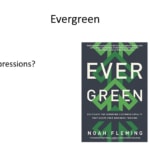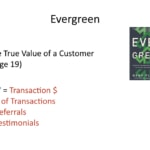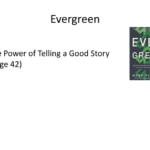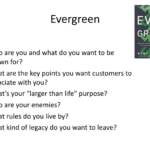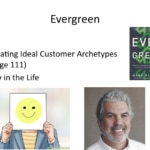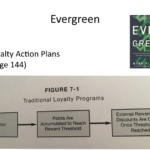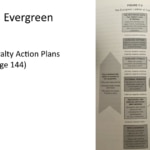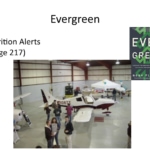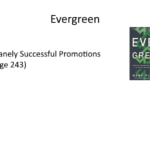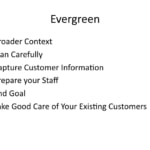“Cultivate the enduring customer loyalty that keeps your business thriving”
The three big ideas from this episode –
- The biggest takeaway is a mindset change- an “evergreen” business is one that grows slowly and continuously, rather than seasonally.
- It’s important to invest and market to existing and past customers, particularly with small niches like aviation.
- It’s also very specific about the type of customer for whom we can do the most good. We like Noah Fleming’s methods of making this happen.
In conversation separate from this one, I was talking with an aircraft broker who could trace 80% of his business to one man. Not that this one man bought and sold so many airplanes, but that so many of his clients were the friends and family of this one man, and he had referred them or that they had referred THEIR family and friends.
Since aviation is such a trust-based business, this is more important to us than it is to people in retail sales or marketing.
Transcript – Discussion about the book Evergreen
[MUSIC]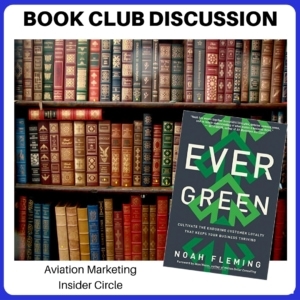 John Williams: You’re listening to aviation marketing Hangar Flying, the community for the best sales and marketing professionals in the aviation industry. You can’t learn to fly just from a book. You learn from other pilots who know the tools, the skills, and the territory. Your hosts, John and Paula Williams, are your sales and marketing test pilots.
John Williams: You’re listening to aviation marketing Hangar Flying, the community for the best sales and marketing professionals in the aviation industry. You can’t learn to fly just from a book. You learn from other pilots who know the tools, the skills, and the territory. Your hosts, John and Paula Williams, are your sales and marketing test pilots.
They take the risks for you, and share strategies, relevant examples, hacks, and how-tos. Be sure to subscribe on iTunes so you won’t miss a thing.
Paula Williams: Welcome to our Book Club Discussion. This month, we are talking about Evergreen – a book about customer loyalty by Noah Fleming. And I have noticed that the thicker the book, the fewer people come to our Book Club Discussions, [LAUGH] so.
John Williams: [LAUGH]
Paula Williams: [LAUGH] That’s part of it. It’s also, Women in Aviation in, let’s see, Lake Buena Vista, Florida. So probably a lot of people are there. In fact, I know a lot of people are there. And HELI-EXPO starts on Monday, so a lot of folks are busy with other things.
But that’s okay, because we’ll have fun without them, won’t we John?
John Williams: Absolutely.
Paula Williams: All right, cool. So, once again, this month’s Book Club Discussion. I’m Paula Williams.
John Williams: And I am John Williams.
Paula Williams: And we are ABCI, and ABCI’s mission is?
John Williams: To help all you ladies and gentlemen out there sell more products or services in the aviation world.
Paula Williams: Absolutely, so if you have-
John Williams: Or both.
Paula Williams: Exactly, so if you have questions about our book club, it’s actually part of our Insider Circle which we started out of self-defense. [LAUGH] Actually we started it because our clients are the smartest people in the aviation industry. And getting them to talk to each other, and getting them to talk about some sales and marketing ideas really brings up a lot of really good stuff that they may not otherwise think of.
And we’ve put together panel discussions and co-marketing agreements, and all kinds of fun things with this particular group of people. And the book club is just one of the ways that we give people an excuse to get together, and also I happen to be a book nerd. I really like sales and marketing and business books and this gives us a chance to, gives me an excuse to play with them and make other people read them, right?
John Williams: Well, encourage other people to read them.
Paula Williams: [LAUGH] Encourage other people to read them exactly. Okay, so let’s start with impressions, what did you think of the book, John?
John Williams: I thought a lot of it was, there were some good points and a lot of chapters that were sort of a rehash of stuff.
Paula Williams: Yeah, well, we read a lot of sales and marketing books. So there were a lot of really similar examples and ideas in here that, not a whole lot that we hadn’t heard before. But I think the big idea, and that was kind of the metaphor of evergreen versus deciduous-
John Williams: [LAUGH]
Paula Williams: Was a good one especially for aviation because we do long cycle of marketing, we have to think in terms of not just one season. We want customers to stay with us forever because there are so few of them for most of our products or services, because they’re so specialized, right?
John Williams: Well, and we, as the rest of the aviation world, take a long view.
Paula Williams: Right.
John Williams: Which is absolutely necessary if you’re going to be in the business of aviation.
Paula Williams: Right.
John Williams: Because there’s such a dramatic cycle of sales versus dry times.
Paula Williams: [LAUGH] Right. And even people that think that they are only making one sale, like brokers, they often have people come back to them every three or four years to trade-in an airplane for a different type or to upgrade or to do something or another or refer people over time.
So even if it seems like a one-time transaction, in the aviation world, it really shouldn’t be, or you really shouldn’t think of anything as a one-time transaction, right?
John Williams: And not only that, there’s been a long drought in aviation prices for, you could argue the reasons but nonetheless, prices of aircraft have been falling for the last several years.
And I think I’m hearing from various people that ought to be in the know.
Paula Williams: Yeah.
John Williams: That were at the bottom and prices in the next few months should probably start up.
Paula Williams: Exactly.
John Williams: Which is good news for everybody.
Paula Williams: Very good news. The really interesting thing is, if you’re driving through California, or Nevada, or Lake Tahoe, or any of the places that, Cody, Wyoming, a lot of other places that have droughts from time to time, and they have lots of evergreens.
You’ll notice that a lot of them survive really well, they survive a lot better than the deciduous trees, right?
John Williams: Yep, yep, absolutely.
Paula Williams: Yeah, so I guess the whole point here is to think about having deep roots and think about needles as opposed to getting great gobs of leaves and then dumping them all [LAUGH] at the end of the season, right?
I like that metaphor. Okay, so getting into the guts of the book. We always put some bookmarks in about things that we thought were particularly notable that we want talk about. And one of the things is on page 19, The True Value of a Customer. And a lot of people ask us, how you do you figure or how do you calculate customer lifetime value?
And so we put the transaction or the equation there on the screen. If you’re listening rather than watching, it says CLV or customer lifetime value equals. And this is not out of the book, I actually got this from our Peak Performers group with GKIC. But it’s the transaction amount times the number of transactions plus the referrals that you get from that particular customer plus the marketing value of any testimonials that you would get.
Because you would pay for good marketing, and testimonials are great marketing. So it’s hard to put a value on that, but maybe priceless? [LAUGH] But you do have to put a value on it for the purpose of figuring out how much customer loyalty is really worth to us.
And it’s almost always more than we thought, right?
John Williams: Yeah, what this guy’s talking about in the book is the fact that a lot of companies average that number.
Paula Williams: Mm-hm.
John Williams: And you can’t do that.
Paula Williams: Right.
John Williams: And he spent 20 pages saying why you can’t do that.
[LAUGH]Paula Williams: Right, [LAUGH] and this is why a lot of the things that come up in these books, we hear over and over and over again in a different way. Same thing, Perry Marshall said in the 80/20 book. 20% of your customers are going to give you 80% of your referrals and testimonials.
John Williams: And he even talks about that in here.
Paula Williams: Right, so good stuff. But nothing we didn’t already know, but I think it can’t hurt to emphasize it again.
John Williams: I think what he was trying to say in 20 pages was that, yeah, I suppose you can go and average numbers but you can’t treat individual customers as average.
Paula Williams: Right.
John Williams: Cuz if you’ve been treated that way before you know why.
Paula Williams: Yeah, [LAUGH] exactly, customers are not commodities and if you treat them like that they will treat you like that then. We can’t have that then.
John Williams: Or they’ll find business elsewhere.
Paula Williams: Exactly, that’s absolutely true.
Okay, next bookmark. The Power of Telling a Good Story.
John Williams: Well, again, That’s how you sell things, is with a story, and if you can’t do a good story, then you’re in trouble.
Paula Williams: Right, this is part of the reason we put together the Storytelling Summit in Sundance, Utah, that we’re planning for August of this year.
A lot of the folks that we work with are very heavily into their own stuff, meaning that they work with it every day. They know why their product is better than the next guy’s, they can tell you chapter and verse. They can tell you the statistics and all of the benefits of their product or all of the features of their product.
But what’s more powerful than that, is telling stories of how it has actually done some good for somebody. It doesn’t really matter if yours is the fastest, or the safest, or the coolest, or the neatest. Unless you can talk about a story where somebody’s life was saved by your product.
That’s probably the ultimate thing in the Aviation Industry. If you could get a story like that, or even how yours contributed to a great story, how your product contributed to do something that was a, a really good human interest story that’s going to capture people’s imagination.
John Williams: And the author refers to another book that says that stories are one of the most important elements of any message that you want to stick, and in business this could not be more true.
Paula Williams: Right, because they’re going to forget the features and benefits, especially if they’re walking around at a trade show going from your booth to your competitors booth. They’re not going to remember the numbers that you throw at them, but they might remember a story, if it’s told well enough. There’s a couple of really good stories that are an illustration of this. Or if you write a great aviation press release or article that has a great story, it’s a lot more memorable.
On this screen I have a picture of a garage, does this mean anything to you, John?
John Williams: Yeah lots of things, not the least of which is how Apple started.
Paula Williams: Exactly, it wouldn’t matter a darn thing, except that the person standing in front of this garage is Steve Jobs.
And this house, that the garage is attached to, happens to be his parent’s house in California. So instantly, you’ve got a hook that connects a lot of pieces of information in your mind, about innovation and perseverance and creative cool kids. The iPhone that’s in your pocket and how it’s neater than everything else that you’ve looked at when you were shopping for cell phones, all of that stuff is tied together with a great story.
That how Apple started with Steve Jobs and Wozniak in a garage, and it’s a really good story. Some of the things, and I really like the bullets that he put together. When you think you have a great story, you want to think about, who are you, and what do you want to known for?
Every company has great stories as far as if it involves people, and it involves something that you built to solve a problem. Then obviously there is a really good story there, you just have to ease it out and figure out what those pieces are. What are the key points that you want customers to associate with you, what is your larger than life purpose?
In Steve Jobs’ case, it’s think differently, that’s one of the things that really sticks out. Who are your enemies? And you don’t have to think of this in terms of, who are your competitors, what are the names of [LAUGH] the individuals who are in the same business as you, who may be taking business from you.
So, our enemies are random acts of marketing. The things that people do, or they’re wasting money, and then coming away with a bad taste in their mouth for sales and marketing. Another one of our enemies is bad sales people who are either dishonest, or unethical in some way, and they leave people with a bad taste in their mouth, those are our enemies, right?
John Williams: Yeah, and the author contends that when you tell a story, that if you start off with what, it ain’t going to work.
Paula Williams: Yeah.
John Williams: You have to start off with why.
Paula Williams: Start with why. What rules do you live by, and what kind of legacy do you want to leave?
These are questions that kind of make you step back and think bigger about your company or your product, or your service or your purpose. And make it 1,000 times more interesting than the widget that you’re trying to sell. Okay, this is Jamie Oliver, I don’t know if you know anything about Jamie Oliver.
Is this a story that you remember John?
John Williams: No.
Paula Williams: Okay just another Food Network cook all right, nobody cares about another Food Network cook. There’s dozens of them, lots of people put out cookbooks, lots of people are chefs on the Food Network are celebrities, or can make you a fabulous salad right?
But what people remember about Jamie Oliver is that he took on the school food system, right, and went after how terrible the food is that we’re serving our kids in public schools. And it’s actually in England, the BBCs that got all crazy about this, this was actually before Michelle Obama and the United States school system, he did it first.
And I think he did it better, because what he did is he went in and started showing the schools how they could teach science in cooking. They could teach science in gardening and he established a lot of gardens in schools and a lot of cooking classes. And science and math and technology and chemistry and fractions, there’s all kinds of things that you can teach by making it practical and by making decent food.
Also, if you feed your kids decent food, that’s a good thing right?
John Williams: Well, of course.
Paula Williams: Okay, so he became known as kind of the bad boy of the BBC, because he was bad mouthing the school officials who were. Not allowing him to do what he wanted and we’re teaching things wrong, and feeding kids terrible things, and so on, right?
John Williams: Yes.
Paula Williams: Cool. So that’s a much better story, I think, than just some guy schlepping cookbooks.
John Williams: [LAUGH] Now stories work all the way. My son before he became a jet pilot.
John Williams: Had come to me to ask me a question about auto mechanics and buying a dual exhaust versus single and the difference in size of the pipes.
And I sat down there and said, well here’s how you convert that story problem into math, and then give me the numbers. And he gave me the numbers and I plugged it in, and I said, so here’s how big the single pipe has to be, and he looked at me and said, I gotta go back to school.
Paula Williams: [LAUGH]
John Williams: And I walked out of the room, and he did, he went back to school. Went to college, and he got out, and he’s flying jets around the country now.
Paula Williams: And you refrained from saying, I told you so.
John Williams: Yeah, that’s right.
Paula Williams: [LAUGH] Okay.
John Williams: [LAUGH]
Paula Williams: Cool. All right, so yeah. You want tothink in terms of stories, because they stick with your customers 1,000 times better than any features or benefits that you can mention. Page 111 is the next bookmark, I think this is a really good one, Creating Ideal Customer Archetypes.
John Williams: So is that how you pronounce it as archetypes? Or is it archetypes?
Paula Williams: Archetype, it’s always been archetype.
John Williams: Right.
Paula Williams: Did you ever take a literature course?
John Williams: [LAUGH] Several. And I’ve heard it pronounced every which way, plus a few more.
Paula Williams: Exactly, no. It started I think in Psychology and then ended up in Literature or vice versa, I never took a Psychology course, cuz I can’t stand the stuff.
John Williams: Yeah, maybe a little.
Paula Williams: Which is really bad being a marketing person, right? I think afraid and young and all those people were kind screwed up.
John Williams: You think?
Paula Williams: Yeah. But that aside.
John Williams: [LAUGH]
Paula Williams: The idea of a customer archetype actually really helps. Because a lot of people think of their customers as a group and they think of them as kind of a faceless group.
Unless you think of one person, it changes your tone. When you’re writing advertising or when you’re creating something that’s going to appeal to somebody, you don’t want tothink of a nameless, faceless customer. You want to think of and we give our customer archetypes. We give them names. It’s Fred or Steve or Joan.
John Williams: So you don’t want to call them the magician, the sage or the jester?
Paula Williams: No [LAUGH], no, we want to pick somebody who’s a really good example of that customer group and we’ve got several customer groups, right? Because we do marketing for charter companies. We do marketing for FBOs, we do marketing for MROs.
We do marketing for people that make widgets.
John Williams: Widgets [LAUGH]?
Paula Williams: Well, components, aircraft components, things like that.
John Williams: Yes, I see.
Paula Williams: People who do services like doctors, lawyers, insurance guys, things like that. But each of those is a different customer archetype, right?
John Williams: Well, I would certainly hope.
Paula Williams: Right, and we have enough experience with those different customer archetypes. That we can pick one and say this guy is pretty representative of this group. So let’s write for Brad and say that is a great archetype. You know what I mean?
John Williams: Or Mark.
Paula Williams: Exactly, we’ve got several Brads and several Marks [LAUGH] .
But that’s a really good way to warm up your writing and warm up your campaigns. And warm up your thinking about your customers because it really affects the way you talk to them. It really affects the way you do your marketing. And makes it a whole lot more effective.
John Williams: True.
Paula Williams: Yeah, all right, so in fact, a lot of times I will scrap something because I’ll say you know what, Mark is going to look at this and think x,y or z. There is something that is going to go off in his head when he sees this. So when I think of an actual person and how they’re going to receive our message.
I throw a lot of paper away [LAUGH] and it takes a lot longer to create a campaign. Or when I’m thinking of a customer’s archetype. One of our customers, I know what their customers are like.
John Williams: So here I thought you were a tree hugger and you’re really a tree killer.
Paula Williams: I am really a tree killer because I have killed a lot of trees doing that and throwing things away because of this exercise, right?
John Williams: Of course.
Paula Williams: One of the exercises that I really like of his, it’s kind of going through a day in the life of your archetype.
You pick a person, you create this character and you go through what is a day, what is his day like? What are the things that are on his mind? What are his problems? What are his other problems besides the ones that I think I can solve for him?
And that affects the way that you market. You might decide to do mail instead of online. Because when he’s online, he’s looking up part numbers and solving problems and things like that. And the last thing he’s going to want todo when he gets done with that task is spend more time online.
So, you may send him a printed brochure. Thinking through a day in the life is really a good way to put yourself in their shoes and start speaking in language that they understand. And empathizing with some of the things going on in their life, right?
John Williams: True.
Paula Williams: Okay, so great exercise.
All right, let’s talk about loyalty plans. Loyalty Action Plans. And we’ve got two that we can kind of contrast that Noah Fleming puts in the book. One has a real simple diagram, the other one has a really complicated diagram.
John Williams: True.
Paula Williams: [LAUGH] And of course,
John Williams: And I don’t know that the-
Paula Williams: The diagrams didn’t hit you very well?
John Williams: No.
Paula Williams: Okay.
John Williams: Too much work.
Paula Williams: Okay.
John Williams: I mean, it seems to me, well, fairly obvious. And you may have an overall loyalty plan program structure, but you have to modify it for each particular customer. As an example, I worked in IT for a number of years and this particular company put together a structure for which an IT request had to go through to get actually approved and financed.
And another gentleman and I were sitting at a meeting and they were going through this. And I looked at him and I said I can’t stand this anymore. He looked at me and grinned. And I stood up and I said look. They said what you’re doing here would be great if you’re building a space shuttle.
Paula Williams: [LAUGH] Right.
John Williams: Because of all this other stuff but it’s doing nothing for you. You have to have points where you can jump off along the way for individual pieces and parts. You have a loyalty program where it’s great for certain people, but you have to be able to jump off in pieces and parse where you have individual employees and companies that are different.
Paula Williams: Right, exactly, and especially in the aviation industry. We’re not a hotel loyalty program or a coffee card that gets punched or something like that. Those kinds of things don’t work for us. Our customers are and most of our clients have customers that are high net worth or ultra high net worth.
They don’t want to play games, they just want to be recognized for the contribution that they’re making to your company. So they may never see your loyalty program on paper or anything else. But they see the effects of it. Because they know they are treated differently. They know they get a thank you gift every time they give you a referral.
They know that you know who they are when they call and you know how much they’ve spent with your company. And how long you’ve been with them and they know about the trip that you took to Barbados five years ago. If you’re a charter company. All of that stuff needs to be collected and you need to have people who are smart enough to apply some general rules, right?
John Williams: Well, I mean I realize that there are some companies this will apply to lock, stock, and barrel. I mean if you have a contract with fuel and you fly a G5 around the country or the world. And as long as you can land and refuel a signature then you don’t get ramp fees charged.
You apply all these credits toward whatever along the way, then yeah, that works. But not everybody’s like that.
Paula Williams: Exactly, and if you are like that and you can put your program together, so that it’s simple from the customer’s point of view. You don’t ever want to show them a diagram like this and make them try to understand it.
But you from your side can make it so that your customer always feels special. That’s all this was about or save some money or see some benefit in doing business with you.
John Williams: By saving them money, you’re making them feel special.
Paula Williams: Yeah, or sees the benefit in doing business with you as opposed to somebody else.
So the thing between these two diagrams, the really simple one versus the complicated one is that he’s got some jumping off Points where customers have increased access to you. Your average customer may not be able to have your cell phone number, as an example. The more they spend and the more transactions they have with you, the more referrals they give you and so on, the higher your involvement with them and the larger your commitment should be to their happiness.
And that’s all this should be about. If you want regiment that, if you want to make a program for that, or make software for that, you can do all kinds of ways to make that happen in the real world, but your customer should never see it. They should just feel it
John Williams: Right.
Paula Williams: Okay cool so loyalty action plans. That’s actually kind of a cool chapter. Probably worth the reading through, right?
John Williams: Yeah if you read this and you read the thing about the [LAUGH] what they call the roach letter
Paula Williams: Do tell because not everybody’s read it, I’m sure.
John Williams: Anyway it’s about a guy that got an airline, international flight from New York to Paris and somewhere along the flight the attendants start serving dinner and then management arrives and he [LAUGH] tried to eat a salad found a big black cockroach in the bottom of it.
Paula Williams: No.
John Williams: Yeah, the [INAUDIBLE] apologized profusely, [INAUDIBLE] to discuss to try anything else, what do you think?
Paula Williams: Yeah, I’m like I’m done I’m not touching any food on this airplane ever again.
John Williams: So the customer’s telling everybody about this thing and then one day a FedEx arrives with an envelope and he stutters and realize it’s from the office of the president of this airline.
And it’s a very nice, very authentic letter it says, here’s the actual take on all of our flights, because of this and all of our providers and this and that. I know we can’t change what happened, but I hope you’ll trust by my response that we’re listening and taking the issue very seriously, and you’ll fly with the airline again.
Yours truly, President ABCL. [LAUGH] And to his amazement he said, finally a company that not only listens to customers, but actually does something about it. Can you imagine, he was able to single handedly ground a 747.
Paula Williams: [LAUGH]
John Williams: So they grounded all their airplanes, and took action.
Paula Williams: Wow. Yeah and I think in a lot of cases that’s all that people want is just acknowledgement that, yes this is terrible and we are going to fix it and they understand, stuff happens. If you can do something about it that is a wonderful thing and tell them what you did about it.
A lot of people would just duck their heads and never want totalk to that guy again.
John Williams: Well, but it continues.
Paula Williams: Okay.
John Williams: So he’s happy. And stuck to the back of the letter he sees what looked like a yellow Post-it note. He flips over the letter and reads the coffee stained note stuck on the back.
Mary Anne, send this jerk the roach letter, Bob.
Paula Williams: No [LAUGH].
John Williams: This was the moment that our realized they didn’t really care about image and experience at all. He was simply sending the standard formula that all passengers find cockroaches in their food, receive.
Paula Williams: Man.
John Williams: Now this is an extreme example, but what matters is we’re living in a time when companies continue to set up systems, blah, blah, blah, and they really don’t care about costumers once they’re paid.
Paula Williams: Yeah.
Paula Williams: So, that was a great story and then it turned out terrible.
John Williams: Yeah, exactly.
Paula Williams: [LAUGH] Had me convinced.
John Williams: So, are you communicating authentically with you customers or are you sending roach letters?
Paula Williams: Are you sending roach letters, good point. That’s a good story.
Okay, let’s talk attrition alerts. This is something that almost never happens in the aviation industry, and should. And I know this from being a flight student that was on-again off-again for various reasons, because of work and geography and everything else. I started at a flight school in Texas, and then finished at a flight school in Utah, but in both cases, I could go weeks between lessons.
And nobody knew or cared [LAUGH] or seemed to care, whether I was coming back or not. I knew my reasons and I knew what was going on with me and things like that, but I had never given any kind of an explanation to the people at the flight school.
Of course, I was responsible for scheduling my own lessons. But two things, one, they should, as part of each lesson, schedule the next one. I mean, you do that at the dentist, you do that at the eye doctor, you do that pretty much everywhere.
John Williams: Sure, you schedule it and then request confirmation, and then it Then you confirm with them in enough time so you can change it for the people.
Paula Williams: Exactly, but if it’s been three weeks since my last lesson, a couple of things happen. One, it’s a perishable skill so you know you’re not doing me any favors if you ignore me if I’m a student. And number two, I’m likely to be shopping around for another flight school.
You have no idea whether I’m stuck at work or whether I was upset
John Williams: Don’t like your instructor
Paula Williams: Didn’t like the instructor, didn’t like something about the airplane. They had no idea So you should have some kind of attrition alerts in place where you know, this customer should have come back to us by now, we really need to make a phone call or send a post card, or something.
And say, you know are you okay? And part of that is just genuine human, did we do something to upset you? And part of that is just good salesmanship.
John Williams: True.
Paula Williams: So a lot of these flight schools, I’m sure, are missing out on hundreds of thousands of revenue because they just let people go away without even an attempt to get them back.
And if there was a problem they could solve easily, they just lost the rest of that customers business for the rest of the time until they get their rating. So that could be tens of thousands of dollars per student and that could be hundreds of thousands of dollars per year if they’re doing that to everybody.
John Williams: Of course.
Paula Williams: Right, so attrition alerts I think could be done in the aviation industry, not just with flight schools. If you have somebody that brings their aircraft back for regular service yeah Jiffylube does a better job [LAUGH] of getting your car back in than MROs do of getting your airplane back.
John Williams: True, actually.
Paula Williams: So you could actually copy those campaigns that you get, make them a little more upscale and a little more interesting, and do some really good work with that. So that’s for MROs. For charter companies, you know people fly more than once. So you should be letting people know it’s time for your annual golf trip or whatever it is that your doing.
There’s lots of ways you can have an alert. Saying we should have heard from this person by now. And get their continuing business. Okay so insanely successful promotions page 243 [LAUGH]. What do you think of this?
John Williams: Now, Groupon aside.
Paula Williams: Yeah.
John Williams: I’m not at all sure.
I’m trying to think back of different folks that have had. This sort of issue and I don’t think except those who did the groupon thing before they realized that was a real big losing proposition without the appropriate qualifications.
Paula Williams: And what John’s talking about, if you’ve not heard of, we’ve done on a couple of our podcast, talked about flight school marketing in particular.
That do a discovery every flight via Groupon, where they’re actually losing money on the fuel and the instructor, in the attempt to get people in the door. Groupon used to heavily influence people to do half-price or half of what their normal price would be for some kind of an incentive to get people in the door with two-for-ones and other kinds of things.
The problem with that is that you end up spending, you actually lose money on the promotion. And then if you don’t capture people’s information to make them a continuing student-
John Williams: Yeah, if you don’t make any sales [INAUDIBLE], you’ve lost big time.
Paula Williams: You’ve lost a huge amount of money on that promotion, as well as potentially losing your reputation as a really high quality institution.
Because when people show up on that day, you’ve overwhelmed and understaffed and so on.
John Williams: It’s a pretty good quote in here.
Paula Williams: Yeah!
John Williams: It says, the worst trap I’ve seen so many companies fall into is that they confuse these types of promotions, this kind of websites as their sole marketing strategy.
Must be clear about something, offering super deep discounts to entice new customers is not marketing.
Paula Williams: Right.
John Williams: [LAUGH]
Paula Williams: There you go, or it’s a random act of marketing. It’s our enemy. [LAUGH]
John Williams: And this is the, on page 244, the books, you can read it yourself.
I didn’t make it up.
Paula Williams: Right, discounts in general are really bad for several reasons. Number one they erode your price integrity. So somebody who bought from you at full price yesterday is going to be upset when you have it for half price today.
John Williams: Exactly.
Paula Williams: Yeah, number two, you’ve got a thing called perceived value.
Especially in this market where if you offer something for half price, you’re perceived value goes out the window. So the equity in your brand all of that prestige and other things you worked so hard to build get under cut by a discount. So we really really discourage them in the aviation industry but we do highly encourage promotions.
You can do a lot of things by adding rather than subtracting. Adding an additional service, providing a reason that people should do X, Y or Z by the end of March, as an example. There’s lots of ways to do that without discounting your price. So guidelines for an insanely successful promotion.
I think these are really good. Every one that you do and John and I actually just did this this morning. We want to think of a promotion in a broader context. You know, what’s our five year plan, what’s our ten year plan? How do we want to grow our company in the most effective way.
John Williams: Without growing it into oblivion.
Paula Williams: [LAUGH] right. So think in the broader of context of what’s your five-year, ten-year plan. Not just how do we get more sales in the door this month? You need to plan it carefully. You need to capture customer information. This one is a key that goes out the window with some of these things.
You want to prepare your staff, make sure that they know what you’re doing and why. And how it’s going to be successful for them. What your end goal is, and you need to above all take good care of your existing customers. So if you can’t do a promotion without sacrificing or if it’s going to sacrifice your existing customers to take too much of your attention away from them, then you don’t want to do that promotion.
John Williams: There are five bullets here that I probably should, I hate reading stuff but-
Paula Williams: That’s okay. Just don’t sound like you’re reading. Nobody will know.
John Williams: [LAUGH] You need to know when you’re going to do a promotion whether it’s Groupon or anything else. First you gotta understand what the promotion is going to cost on the front end.
Paula Williams: Right.
John Williams: Second is at what point will you break even, with a nuke or successive how many customers it take to break even. And third can you negotiate a better profit split? It’s always a question for bullet number one. And how many new customers can you realistically handle which is something we have to deal with all the time because as our numbers of customers grow.
That’s fine, we can handle it. They need to be on board and working. Then we can have the more new ones.
Paula Williams: Right.
John Williams: But if we’ve got four or five new ones to start with, then it makes it very, very time consuming.
Paula Williams: [LAUGH]. In other words, long hours for Paula and John because we do personally get involved with new clients pretty much the first three months.
John Williams: And then how many, and what discounts are you willing to offer and when will they expire. So, just things have very high level that you should consider before executing a promotion of any kind.
Paula Williams: Absolutely, so all together, a really good book. Definitely worth the read. Great job Noah Flemming.
I actually just had the couple little chats with them on Twitter but seems like a really decent guy, he’s got a really good blog. So highly recommend following that and I know he’s got a couple of other books that have come out since then that may not be quite so relevant to the aviation industry as Evergreen.
So, that’s why we picked that one. So what do you think? Should we give it a nine out of ten?
John Williams: Naw, I’d probably do eight and a half, but okay nine.
Paula Williams: [LAUGH] Eight and a half, okay. Definitely worth the read, but-
John Williams: Yeah.
Paula Williams: Yeah.
John Williams: That’s good enough.
Paula Williams: Okay, so next month we have a skinny book. So we’ll probably have lots of people in our book club discussion hopefully. And that one is Content that Converts by Laura Hanly and this one is actually especially about content for business to business, or B2B sales and marketing, which it’s unusual most of the content marketing materials that are out there are for retail.
So this is actually a little more relevant to us than most of the stuff you’ll run across the web and in the book store. So next up, I’m really looking forward to it. And we will be discussing that book on March, sorry, April 5th, Wednesday at one o’clock.
So if you’re one of our insiders, put that on your calendar, and-
John Williams: Actually should already be there if you have one of our calendars.
Paula Williams: It is already there if you have one of our calendars, so just make sure you circle that, and plan to join us for that.
It’s going to be a really good discussion so thanks for joining us and have a great afternoon.[SOUND]
Announcer: Thanks for joining us for aviation marketing Hangar Flying, the best place to learn what really works in sales and marketing in the aviation industry. Remember to subscribe on iTunes and leave a rating.
[MUSIC]document.currentScript.parentNode.insertBefore(s, document.currentScript);..
Podcast: Play in new window | Download
Subscribe: Spotify | Amazon Music | RSS



